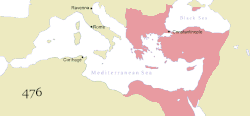Twenty Years' Anarchy
Byzantine Empire Βασιλεία Ῥωμαίων ( Emperor | |||||||||
|---|---|---|---|---|---|---|---|---|---|
• 695–698 | Leontius | ||||||||
• 698–705 | Tiberius III | ||||||||
• 705–711 | Justinian II (restored; second term) | ||||||||
• 711–713 | Philippicus | ||||||||
• 713–715 | Anastasius II | ||||||||
• 715–717 | Theodosius III | ||||||||
| History | |||||||||
• First deposition of Justinian II | 695 | ||||||||
• Deposition of Theodosius III | 717 | ||||||||
| |||||||||
| History of the Byzantine Empire |
|---|
 |
| Preceding |
|
| Early period (330–717) |
|
| Middle period (717–1204) |
| Late period (1204–1453) |
| Timeline |
| By topic |
|
|
The Twenty Years' Anarchy is a
Justinian II and the usurpers - 685–711
The reign of Justinian II (685–711) became increasingly despotic and violent, and his policies met with considerable opposition. He was eventually deposed and exiled by Leontius (695–698) in 695, precipitating a prolonged period of instability and anarchy, with seven emperors in twenty-two years.[3]
Leontius was popular at first, though the loss of Carthage soon ruined his reputation. John the Patrician led a navy to Carthage, losing in 698. The army feared Leontius, in the same year he was overthrown by Tiberius III (698–705). Tiberius managed to bolster the eastern frontier and reinforced the defenses of Constantinople, but meanwhile Justinian was conspiring to make a comeback and after forming an alliance with the Bulgars succeeded in taking Constantinople and executing Tiberius.
Justinian then continued to reign for a further six years (705–711). His treatment of Tiberius and his supporters had been brutal and he continued to rule in a manner that was despotic and cruel. He lost the ground regained by Tiberius in the east, and imposed his views on the Pope. However, before long he faced a rebellion led by
Philippicus - 711–713
Anastasius II - 713–715
Anastasius reversed his predecessor's religious policies and responded to Arab attacks by sea and land, this time reaching as far as Galatia in 714, with some success. However, the very army that had placed him on the throne (the Opsikion army) rose against him, proclaimed a new emperor and besieged Constantinople for six months, eventually forcing Anastasius to flee.
Theodosius III - 715–717
The troops had proclaimed
It is surprising that the Byzantine Empire was able to survive, given its internal problems, the speed with which the Sasanian Empire collapsed under the Arab threat and the fact that it was being threatened simultaneously on two fronts. However, the strength of the military organization within the empire, and factional struggles within the Arab world, enabled it to do so.
References
See also
- Arab–Byzantine wars
- Byzantine–Bulgarian Wars#Tervel's wars
- Family tree of Byzantine emperors
Sources
- Kaegi, Walter Emil (1992). Byzantium and the Early Islamic Conquests. Cambridge, United Kingdom: Cambridge University Press. ISBN 978-0-521-41172-1.
- Bellinger, Alfred Raymond; Grierson, Philip, eds. (1992). Catalogue of the Byzantine Coins in the Dumbarton Oaks Collection and in the Whittemore Collection: Phocas to Theodosius III, 602–717. Part 1. Phocas and Heraclius (602–641). ISBN 9780884020240.
- Jenkins, Romilly (1966). Byzantium The Imperial centuries AD 610–1071. Weidenfeld & Nicolson ISBN 0-8020-6667-4
